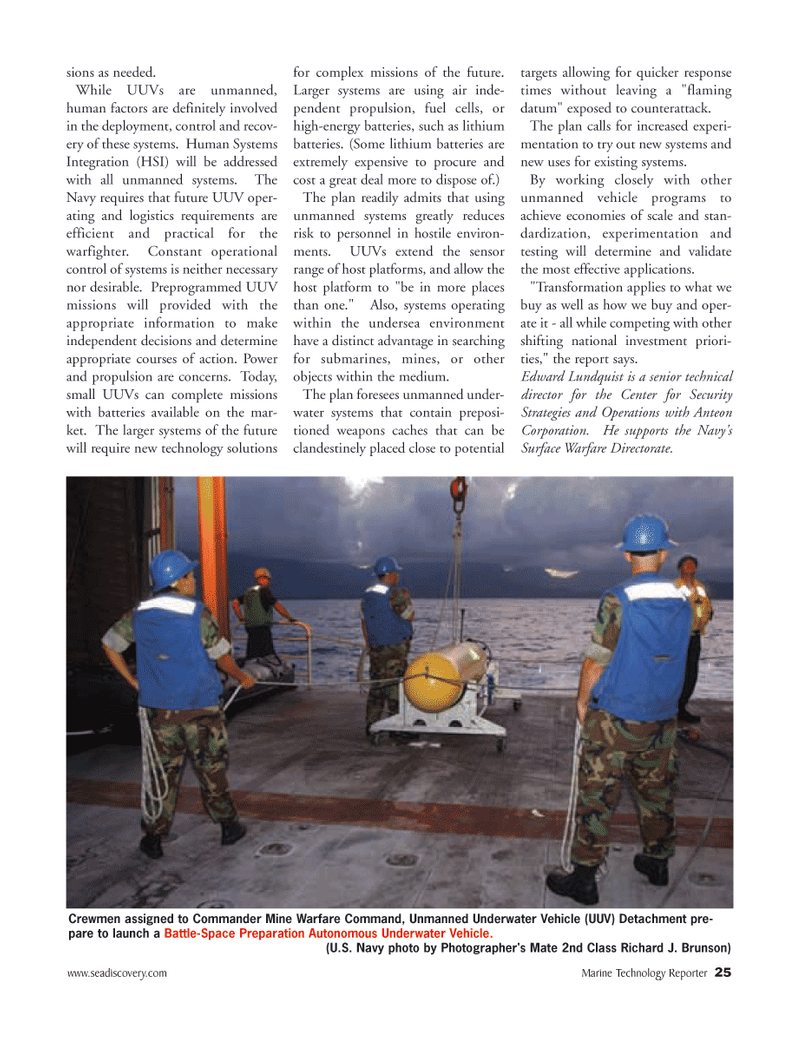
Page 24: of Marine Technology Magazine (July 2005)
Read this page in Pdf, Flash or Html5 edition of July 2005 Marine Technology Magazine
www.seadiscovery.com Marine Technology Reporter 25 sions as needed.
While UUVs are unmanned, human factors are definitely involved in the deployment, control and recov- ery of these systems. Human Systems
Integration (HSI) will be addressed with all unmanned systems. The
Navy requires that future UUV oper- ating and logistics requirements are efficient and practical for the warfighter. Constant operational control of systems is neither necessary nor desirable. Preprogrammed UUV missions will provided with the appropriate information to make independent decisions and determine appropriate courses of action. Power and propulsion are concerns. Today, small UUVs can complete missions with batteries available on the mar- ket. The larger systems of the future will require new technology solutions for complex missions of the future.
Larger systems are using air inde- pendent propulsion, fuel cells, or high-energy batteries, such as lithium batteries. (Some lithium batteries are extremely expensive to procure and cost a great deal more to dispose of.)
The plan readily admits that using unmanned systems greatly reduces risk to personnel in hostile environ- ments. UUVs extend the sensor range of host platforms, and allow the host platform to "be in more places than one." Also, systems operating within the undersea environment have a distinct advantage in searching for submarines, mines, or other objects within the medium.
The plan foresees unmanned under- water systems that contain preposi- tioned weapons caches that can be clandestinely placed close to potential targets allowing for quicker response times without leaving a "flaming datum" exposed to counterattack.
The plan calls for increased experi- mentation to try out new systems and new uses for existing systems.
By working closely with other unmanned vehicle programs to achieve economies of scale and stan- dardization, experimentation and testing will determine and validate the most effective applications. "Transformation applies to what we buy as well as how we buy and oper- ate it - all while competing with other shifting national investment priori- ties," the report says.
Edward Lundquist is a senior technical director for the Center for Security
Strategies and Operations with Anteon
Corporation. He supports the Navy's
Surface Warfare Directorate.
Crewmen assigned to Commander Mine Warfare Command, Unmanned Underwater Vehicle (UUV) Detachment pre- pare to launch a Battle-Space Preparation Autonomous Underwater Vehicle. (U.S. Navy photo by Photographer's Mate 2nd Class Richard J. Brunson)
MTR#1 (17-32).qxd 7/19/2005 10:00 AM Page 25

 23
23

 25
25
